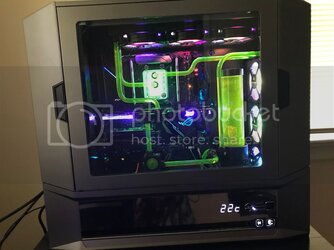I just finished building my new PC from the ground up and I have one main question that I couldn't seem to find on the web, then a couple secondary questions about my rig and some solutions to things I'm not happy about.
Main Question: what is considered average internal case temperature? What is considered on the hotter side and what is considered superbly cool? Not the temperature of any individual component, just ambient air inside the cases 6 walls. I am now curious because this is the first case (EVGA DG-87) I have owned with a temp sensor built into the case. It is on the end of a tail that comes from the front I/O with the rest of the connectors. Without altering the fan curve in the BIOS, I have seen this probe report 30c just doing 2K@165hz gaming. I upped the curve just a little on 6 of the fans attached to a chassis fan header (the one intaking air from the front of the case) and saw internal case temp drop to 27-28c doing the same activity.
Secondary questions:
1.what would be the ideal place to have this sensor without it looking tacky? Warm air rises and there's nothing at the bottom of the case save for the PSU so it's sort of pointless to have it down there and the front temp readout will not be indicative of anything important.
2. my current setup has 2x 360mm rads with 12 fans in push/pull. I assembled it all using 2 Silverstone 1->8 fan hubs. I assumed the BIOS wouldn't much like not having something plugged into the CPU fan header so one of the hubs is plugged into that. Well apparently because of the HUB, the BIOS gets a CPU fan speed error so right now I have the BIOS set to ignore it. The problem is, this prevents the use of a fan curve for temps if you're ignoring the headers temps. I was thinking of just moving this hub to a chassis fan header and still having the CPU header on ignore, but this will only ramp up if the cases temp gets high... If anyone can offer an ideal solution, I would be forever grateful. Component temps are great, I just don't like the computer not functioning the way it did in my mind before I started building it. Build pics attached.
Case: EVGA DG-97
Mobo: ASUS Zenith Extreme
CPU: 1950x
Cooling loop: EK blocks, rads and D5 pump/res combo
GPU: EVGA 1080ti FTW3
RAM: 16gb Ballistix DDR4 2666 (shoulda gone faster, I know lol will rectify later)
PSU: EVGA 1000w 80+ platinum
Thanks in advance for advice/recommendations folks!

Main Question: what is considered average internal case temperature? What is considered on the hotter side and what is considered superbly cool? Not the temperature of any individual component, just ambient air inside the cases 6 walls. I am now curious because this is the first case (EVGA DG-87) I have owned with a temp sensor built into the case. It is on the end of a tail that comes from the front I/O with the rest of the connectors. Without altering the fan curve in the BIOS, I have seen this probe report 30c just doing 2K@165hz gaming. I upped the curve just a little on 6 of the fans attached to a chassis fan header (the one intaking air from the front of the case) and saw internal case temp drop to 27-28c doing the same activity.
Secondary questions:
1.what would be the ideal place to have this sensor without it looking tacky? Warm air rises and there's nothing at the bottom of the case save for the PSU so it's sort of pointless to have it down there and the front temp readout will not be indicative of anything important.
2. my current setup has 2x 360mm rads with 12 fans in push/pull. I assembled it all using 2 Silverstone 1->8 fan hubs. I assumed the BIOS wouldn't much like not having something plugged into the CPU fan header so one of the hubs is plugged into that. Well apparently because of the HUB, the BIOS gets a CPU fan speed error so right now I have the BIOS set to ignore it. The problem is, this prevents the use of a fan curve for temps if you're ignoring the headers temps. I was thinking of just moving this hub to a chassis fan header and still having the CPU header on ignore, but this will only ramp up if the cases temp gets high... If anyone can offer an ideal solution, I would be forever grateful. Component temps are great, I just don't like the computer not functioning the way it did in my mind before I started building it. Build pics attached.
Case: EVGA DG-97
Mobo: ASUS Zenith Extreme
CPU: 1950x
Cooling loop: EK blocks, rads and D5 pump/res combo
GPU: EVGA 1080ti FTW3
RAM: 16gb Ballistix DDR4 2666 (shoulda gone faster, I know lol will rectify later)
PSU: EVGA 1000w 80+ platinum
Thanks in advance for advice/recommendations folks!

Last edited: